Do your homework, and research what is involved in caring for a reptile, before selecting the species that you want to keep.
The popularity of reptile pets continues to grow. Consequently, more reptiles are being presented to veterinarians, and owner’s expectations regarding their veterinary care are also increasing. Although reptiles are promoted as low-maintenance pets, they still require daily attention. Do your homework, and research what is involved in caring for a reptile, including the habits and behavior of different species, housing, heating, humidity, lighting, cleaning, feeding and any other relevant husbandry information, before selecting the species that you want to keep. Once you’ve made your choice, the following tips will help you to keep that herp healthy.
1. Have Your Reptile Examined By A Herp Vet
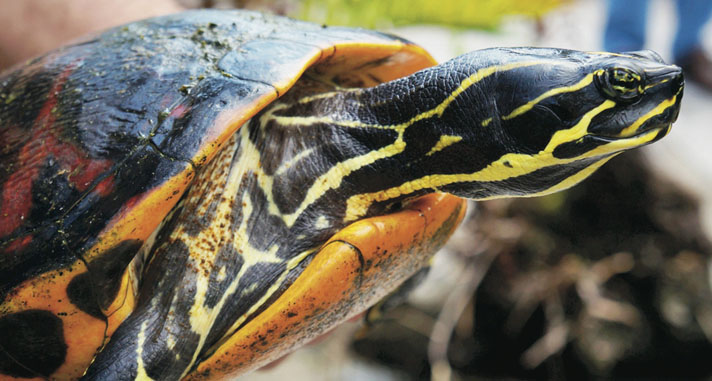
Dr. Orlando Diaz-Figueroa
Having your pet reptile examined on a routine basis is the best way to potentially detect a disease process before it gets serious. Post-purchase examination and routine preventative care are important when keeping reptiles.
Post-purchase examinations are an excellent way to find out more about your pet’s health and correct poor husbandry practices before you make mistakes and adopt bad habits. Although you can learn a lot from species-specific captive-care articles, you will also learn a lot about your pet by having a clinician perform a full physical examination and offer other preventive health services. Fecal examination, blood screening and survey radiographs are a few of the diagnostic modalities performed during an examination that can help identify potential problems at an early stage.
The majority of reptile diseases are caused, either directly or indirectly, by substandard husbandry; therefore, a thorough review of husbandry practices, hygiene and nutrition is essential before a standard physical examination. Indeed, it is impossible to evaluate the reptile patient without an understanding of correct management.
Keep a history of your husbandry practices and bring those with you to your veterinarian appointment. Even if you have not had your pet for very long, do your best to get information from the breeder or person who sold you the animal. The more data you can give your veterinarian, the better. Qualitative and quantitative changes in thermal provision, lighting, humidity, vivarium furnishings, food and water consumption, feces, urine or urates, ecdysis (sheds) and behavior should be detailed. Specific changes associated with breeding and hibernation are frequently associated with disease problems, and therefore, be ready to answer questions as to if your reptile has been bred and how often. Recent additions to the reptile collection as well as quarantine protocols are also highly significant. If you have not isolated a new animal before placing it within a healthy, established group.
The length of time a reptile has been in a specific environment is important. Animals presented within a few days of acquisition are unlikely to be suffering from subtle husbandry problems associated with their new environment, although severe deviations in temperature and unfamiliar food items offered will cause immediate problems. In such recent acquisitions, the previous practices with importation, wholesalers and retailers are probably more important aspects of the history. Conversely, specimens that have been maintained for more than two months in an owner’s care are more likely to experience problems associated with the home environment.
The importance of identifying which species and subspecies you have cannot be overemphasized. In certain cases, even locality may cause diet and environmental preferences within the same species.
Different species from different geographic locations must never be mixed. Ideally, only a single species should be kept in any enclosure, and care must be exercised to avoid competition for resources, such as food, basking areas and hides. Most non-breeding pet snakes are best maintained in solitude, as severe trauma while feeding is not uncommon in communally housed boas and pythons. Aggression is well documented in the kingsnakes, which can eat their serpentine cagemates. Male lizards are often territorial and aggressive toward other mature males (e.g., leopard geckos, green iguanas, etc.). Some species, in particular the chameleons, are so territorial that isolation is often essential (unless breeding is attempted) for their long-term survival in captivity. For other lizard species, such as basilisks, collard lizards and bearded dragons, maintaining a male and female pair, trio or group, may be possible with the proper vivarium size. In fact, with access to very large enclosures, it may even be possible to maintain various subspecies, such as day geckos, in the same enclosure. However, in general, the solitary reptile is usually the healthiest pet.
2. Quarantine Your Reptiles
Never place a newly acquired animal in with an established collection. A lack of appropriate quarantine is one of the major causes of disease outbreaks in large, private collections. Unfortunately, the incubation period for many reptile ailments has not been determined, but a quarantine period of at least three months and preferably six months is advisable. New additions should enter and leave the quarantine area at the same time. The quarantine enclosures should be situated far away from the main collection in a separate air space, and quarantined animals must have their own separate water and food containers, snake hooks, gloves and other equipment. Quarantined reptiles should be seen to after one works the main collection; spread of infection by fomites or the keeper is all too common.
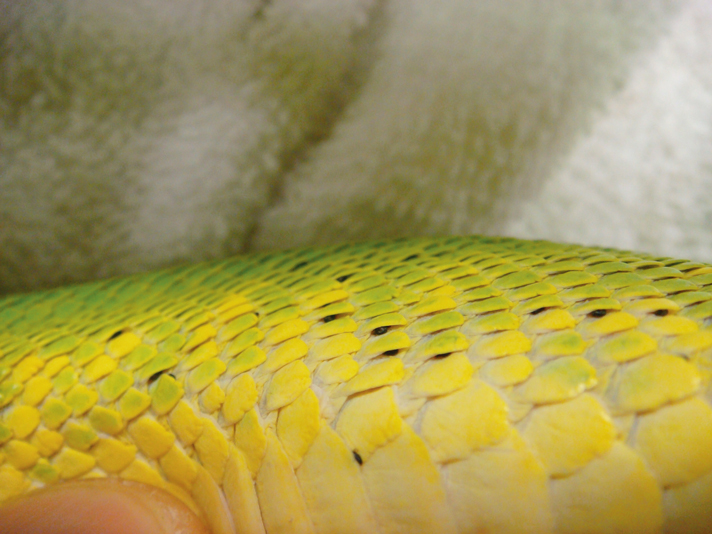
Dr. Orlando Diaz-Figueroa
Mite infestation in an emerald tree boa (Corallus caninus).
Any reptile with mites or ticks should be appropriately treated. The decision to treat subclinical endoparasites is perhaps debatable. Some authorities argue that all healthy wild reptiles possess parasites and the need for prophylactic treatment is questionable. I prefer to perform a routine fecal examination and to treat any parasitized reptile with appropriate drugs, as placing reptiles in captivity upsets the natural reptile-parasite relation and predisposes to disease, especially where parasites with a direct life cycle are concerned. Protozoa are, in many cases, a symbiotic organism, especially in herbivorous reptiles, and so routine treatment is not required unless there is concurrent anorexia or diarrhea.
New arrivals should be accurately weighed and measured. During the quarantine period, weight, appetite, accepted and refused food items, behavior, activity and defecation should all be monitored and recorded.
3. Reptile Enclosure Essentials
The type of enclosure (arboreal, terrestrial, subterranean or aquatic) should be appropriate for the species. Arboreal species, such as green iguanas and emerald tree boas, prefer to move on a vertical plane, whereas terrestrial species, such as skinks and rat snakes, prefer a more down-to-earth, horizontal existence. Enclosure size is also important, and although many breeders and retailers may be able to manage stock intensively, I advise my clients to provide the largest appropriate enclosure possible.
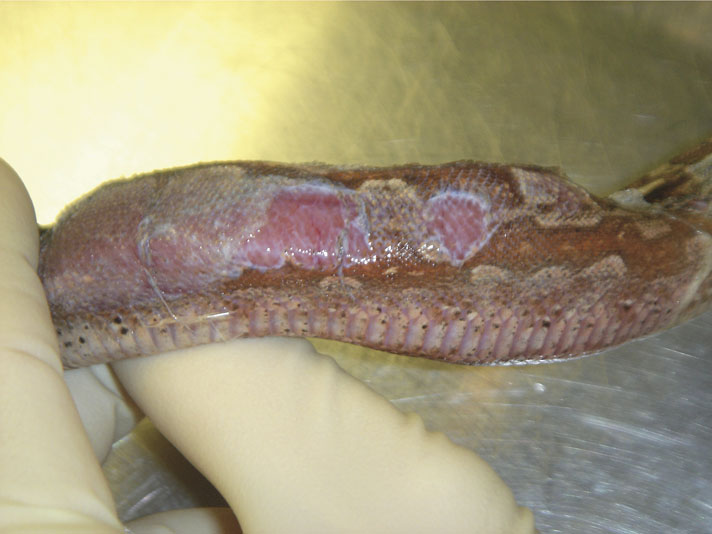
Dr. Orlando Diaz-Figueroa
Vesicular dermatitis (blister disease) associated with an overly moist snake environment and poor ventilation led to skin lesions that later became infected.
Glass aquaria are commonly used, but the greater visualization perceived as an advantage to the owner may serve as a stressful reminder of open exposure and poor security to the inmate. Glass is a poor insulator, and greater heat loss may lead to drastic temperature fluctuations. Even if a mesh covers the entire top of the enclosure, ventilation may be severely reduced because of a lack of adequate air flow along the sides and the back wall. Plastic-coated wooden enclosures are popular because they are more versatile by permitting the incorporation of additional ventilation panels, front access by sliding glass doors and greater security for the inhabitants. More recently, plastic and fiberglass enclosures are increasingly in demand. Some of the plastic cages are made with a molded, one-piece construction from durable, impact-resistant polyethylene or polycarbonate. This makes them easy to clean (chemical resistant) and easy to light and heat. They are molded to allow easy light attachment. Most models have a heat lamp shroud built directly in. Some of these plastic enclosures are stackable, which are great for conserving space if you have lots of reptiles. This feature alone makes them worth the price. Their main advantage is that they can be thoroughly cleaned and disinfected without the risk of moisture damage associated with wooden enclosures.
Naturalistic substrate materials are sometimes changed infrequently by inexperienced keepers because of their higher cost in comparison to newspaper or reusable artificial grass. Some material can cause contact dermatitis, mouth rot (infectious stomatitis) or intestinal impaction if ingested. Natural wooden materials and live plants may introduce and harbor parasites or be toxic if not chosen wisely, whereas plastic dÈcor may form an unexpected, indigestible addition to the diet if it is small enough to fit into the reptile’s mouth. In addition, hideouts or retreats are sometimes overlooked, or when they are provided, they may be too spacious to provide adequate security.
It is unfortunate that many owners only decide it is time to clean the vivarium once a foul odor become obvious. Few reptiles naturally excrete, or are trained to excrete, in one area. Therefore, poor hygiene is a common fault. The choice of cleaning agent is also worthy of note, as some are toxic, such as pine oil, cresols, formaldehyde, etc. One disinfectant commonly used in reptile husbandry is chlorhexidine, a broad-spectrum antimicrobial that can be used even in the presence of organic material and other antiseptics.
4. Temperature, Lighting, And Humidity For Captive Reptiles
Temperature, lighting, humidity, moisture level and water quality profoundly impact a reptile’s health and behavior. Successful husbandry depends on controlling these parameters to stimulate their natural habitat.
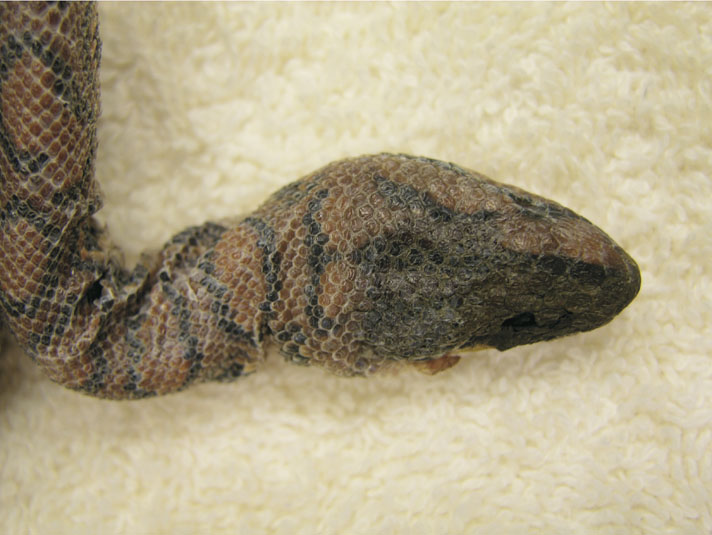
Dr. Orlando Diaz-Figueroa
A severe case of a generalized dysecdysis in a Brazilian rainbow boa (Epicrates c. cenchria) secondary to poor husbandry. This animal was diagnosed with kidney disease (renal failure).
Lighting
Full-spectrum fluorescent lights, which purport to duplicate the spectral characteristics of natural sunlight, are readily available at pet stores. Do not confuse these lights with grow lights for plants, or with full- or wide-tungsten filament incandescent lamps sold for lighting animal enclosures. Those lights are deficient or completely lacking UVB radiation. This portion of the spectral band (290 to 320 nm) is essential to vitamin D3 biogenesis, which plays an essential role in calcium metabolism in reptiles.
Most snakes do not have any significant requirement for broad- or full-spectrum lighting. However, many diurnal lizards and chelonians require lights for the production of vitamin D3. There is also some indication that natural light has behavioral and physiological benefits. The best source of quality, full-spectrum lighting is unfiltered sunlight. For indoor lighting, a suitable bulb must be placed within 12 inches of the reptile and replaced every six to 12 months. The high-UV output black lights have been associated with anorexia and ocular damage, but many breeders and retailers have reported success when they are used in conjunction with a white light to offset the blue hue of the black light. Most transparent plastic and glass barriers filter out the UVB wavelength; therefore, placing a reptile in a greenhouse or conservatory for exposure to the UVB provided by sunlight is not acceptable unless specialized UVB transmitting materials are used.
Unfortunately, many reptile owners do not know the exact photoperiod, age, position, make and model of the light they are using within their vivarium. And in many cases, captive lighting is deficient in one or more of these facets. Keep a log of when you have changed out your lights and what you have placed within the enclosure. This will help you track when they need to be replaced and what has and has not worked well.
Reptile Heating Needs
There are a variety of heaters that may be employed, including incandescent bulbs, infrared ceramics, heating pads or mats, warming cables, tubular heaters, radiators, convector heaters and natural sunlight radiation. Many times, the heating equipment supplied by the owner is insufficient to provide the preferred optimum temperature zone (POTZ) for the reptile. Inadequate heating is a common cause of immunosuppression, which is a frequent predisposing factor in many disease situations. While offering enough heat is important, you also need to place the heater at a good distance from the animal so that you prevent it from becoming burned. This is especially important when faced with high-surface-temperature heaters, such as the infrared ceramics and incandescent spotlights.
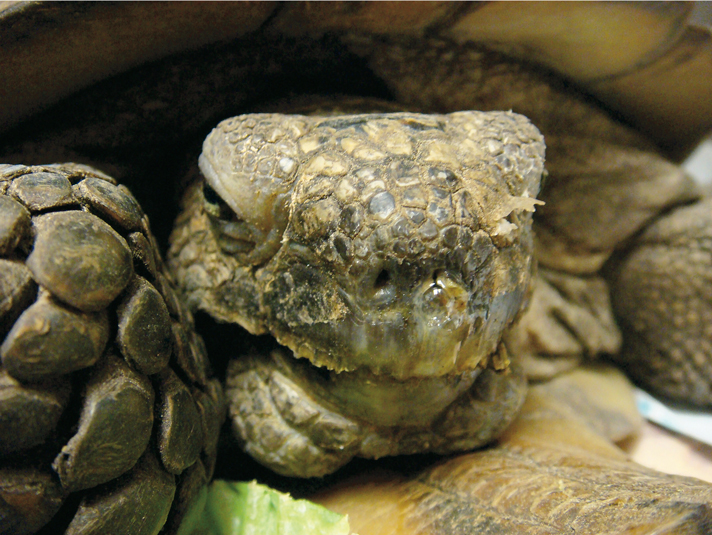
Dr. Orlando Diaz-Figueroa
Chronic rhinitis in a gopher tortoise (Gopherus polyphemus) associated with Herpes virus infection. Animals like this should be kept in quarantine away from healthy collections.
Most terrestrial reptiles, especially chelonians, have evolved to obtain maximum benefit from a radiating overhead heat source—the sun. In captivity, an overhead radiant heat source is also required. Under-floor heat mats are often inappropriate and can increase the likelihood of gastrointestinal disease, as well as plastron osteomyelitis. Heat mats are more appropriate for many small- to medium-sized snakes, unless they are burrowing species. Obviously, a burrowing snake that tries to escape the heat only to be faced by the seemingly contradictory experience of actually getting closer to the heat source the deeper it burrows, would not benefit from a heat mat.
In addition to a heat source, a suitable thermal gradient is also a must. Most arboreal species thermoregulate on a vertical plane; therefore, heating should be positioned in the roof of the enclosure. Terrestrial species tend to move along a more horizontal plane; for these cases, all heating should be concentrated at one end and not evenly distributed throughout the length of the vivarium. Finally, captive aquatic environments seldom permit the establishment of a water-temperature gradient, but acceptable water temperatures should be provided with a dedicated double-insulated water heater. Electrical cords must be protected from the powerful bite of aquatic chelonians, as electrocution is not only fatal to the animal being kept but presents serious threats for the keeper as well.
Reptile Humidity Requirements
This is often the most overlooked aspect of the captive environment, and even the most enthusiastic keeper often fails to install a hydrometer within the vivarium.
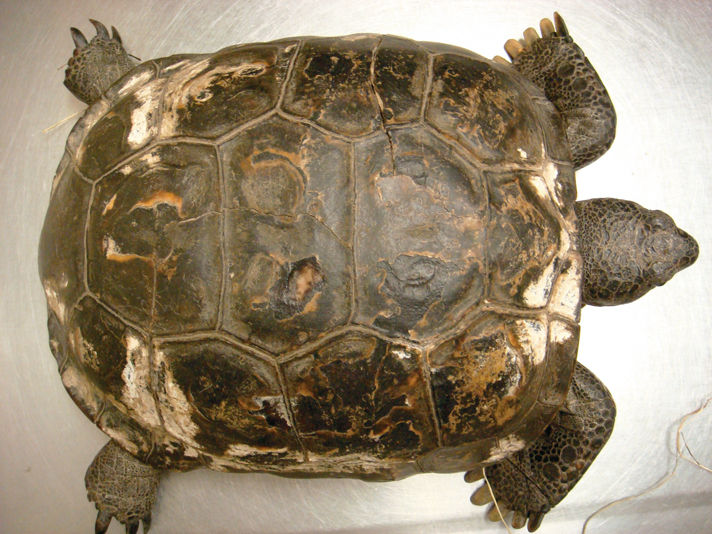
Dr. Orlando Diaz-Figueroa
Shell degradation in a gopher tortoise (Gopherus polyphemus). The condition has been associated with ingested environmental toxicants, bacteria and fungal disease.
Humidity tends to be a function of temperature, water surface area and ventilation. The major problem in most cases is the view that ventilation must be decreased to increase humidity. Such action results in stagnant air and an increase in bacterial and fungal infections, especially in the skin and the respiratory system. It is better to maintain ventilation and regulate humidity by providing a greater water surface area (shallow water containers and regular spraying) or an increase in water temperature by placing a heat mat under a shallow water container.
5. Reptile Diseases
Reptiles, like all other animal groups, can be responsible for disease in humans. I do not believe the risks of reptile-borne zoonoses to be any greater than for other animal groups. Basic personal hygiene after handling a reptile reduces these risks to an acceptable level. The major potential zoonotic risks include Salmonella sp., Pseudomonas sp., Mycobacteria sp., Cryptosporidia sp., Giardia sp., Rickettsia sp. and pentastomids (arachnid lung parasites). Major public concern centers around the commensal reptile salmonellas, and reptile keepers and veterinarians are advised to obtain a copy of the statement policy on this subject provided by the Association of Reptilian and Amphibian Veterinarians (ARAV).
In Closing
Following these common-sense practices will go a long way to ensuring that your reptiles, and you, stay healthy. Keep in mind that good health always begins with prevention. Addressing poor husbandry practices early will save you a great deal of money at the veterinarian’s office throughout the years and will save your pet from needless suffering.
Dr. Diaz-Figueroa completed his internship in companion avian/exotic and small animal medicine at Animal Care Unlimited and the Ohio Wildlife Center in 2002, and then went on to a three-year residency in zoological medicine at the Louisiana State University. In December 2006, he became a Diplomate of the American Board of Veterinary Practitioners, Avian Specialty. Dr. Diaz-Figueroa regularly speaks to local clubs and schools about exotic pet care, and he has authored numerous articles and book chapters in professional texts and journals. His special interests are in avian obstetrics and reptilian gastrointestinal diseases. Other areas of interest include avian endoscopy, ferret endocrine diseases, rabbit infectious diseases, and exotic animal orthopedics. Dr. Diaz-Figueroa is the owner of Lake Howell Animal Clinic in Maitland, Fla. (lakehowellanimalclinic.com).



